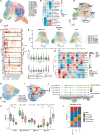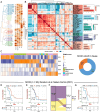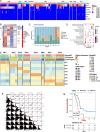Dissecting small cell carcinoma of the esophagus ecosystem by single-cell transcriptomic analysis
- PMID: 40375239
- PMCID: PMC12079819
- DOI: 10.1186/s12943-025-02335-5
Dissecting small cell carcinoma of the esophagus ecosystem by single-cell transcriptomic analysis
Abstract
Small cell carcinoma of the esophagus (SCCE) is an aggressive and rare neuroendocrine malignancy with poor prognosis. Here, we firstly performed single-cell transcriptional profiling derived from 10 SCCE patients, with normal esophageal mucosa, adjacent non-malignant tissue and tumors from esophageal squamous cell carcinoma (ESCC) as reference. We observed enrichment of activated regulatory T cells and an angiogenesis-induced niche existed in SCCE compared with ESCC, revealing an immune suppressive and vessel-induced tumor microenvironment (TME) in SCCE. Totally, we identified five TME ecotypes (EC1 ~ 5). Notably, EC1 was highly enriched in SCCE, associating with molecular subtyping and survival outcomes. To dissecting heterogeneity of epithelium in SCCE, we constructed eight transcriptional metaprograms (MPs) that underscored significant heterogeneity of SCCE. High expression of MP5 was linked to neuroendocrine phenotype and poor clinical survival. Collectively, these results, for the first time, systematically deciphered the TME and epithelial heterogeneity of SCCE and provided evidences that SCCE patients might benefit from anti-angiogenesis therapy.
© 2025. The Author(s).
Conflict of interest statement
Declarations. Ethics approval and consent to participate: This study was approved by the Ethics Committees of Sun Yat-sen University Cancer Center (No. B2020 - 311–01). Written informed consent was obtained from all patients in this study. Consent for publication: Not applicable. Competing interests: The authors declare no competing interests.
Figures






References
-
- Shah MA, Altorki N, Patel P, Harrison S, Bass A, Abrams JA. Improving outcomes in patients with oesophageal cancer. Nat Rev Clin Oncol. 2023;20(6):390–407. - PubMed
-
- Zhang C, Zhang G, Xue L, Zhang Z, Zeng Q, Wu P, et al. Patterns and prognostic values of programmed cell death-ligand 1 expression and CD8 + T-cell infiltration in small cell carcinoma of the esophagus: a retrospective analysis of 34 years of National Cancer Center data in China. Int J Surg. 2024;110(7):4297–309. - PMC - PubMed
-
- Chen S, Wang XM, Wu F, Huang C, Gao TT, Zhang ZW, et al. Primary small cell carcinoma of the esophagus in a large multicenter cohort: prognostic factors and treatment strategies in the modern era. Int J Radiat Oncol Biol Phys. 2023;117(2):e286–7.
-
- Xu L, Li Y, Liu X, Sun H, Zhang R, Zhang J, et al. Treatment strategies and prognostic factors of limited-stage primary small cell carcinoma of the esophagus. J Thorac Oncol. 2017;12(12):1834–44. - PubMed
MeSH terms
Substances
Grants and funding
- 82102921/National Natural Science Foundation of China
- 82321003/National Natural Science Foundation of China
- Q202412/the Guangdong Esophageal Cancer Institute Science and Technology Program
- 2023ZD0501600/the Noncommunicable Chronic Diseases-National Science and Technology Major Project
- 2019-I2M-5-036/CAMS Innovation Fund for Medical Sciences (CIFMS)
- CIRP-SYSUCC-0004/Cancer Innovative Research Program of Sun Yat-sen University Cancer Center
- 84000-31630002/Sun Yat-sen University clinical research 5010 program
- 202206080011/Science and Technology Program of Guangzhou
- 82061160373/the International Cooperation and Exchanges National Natural Science Foundation of China
- 84000-31620003/the Fundamental Research Funds for the Central Universities, Sun Yat-sen University
LinkOut - more resources
Full Text Sources
Medical

